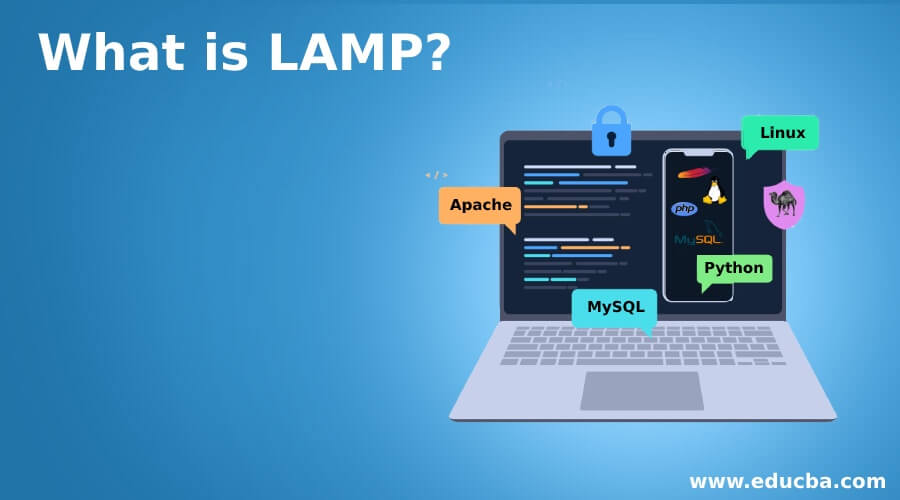Updated April 13, 2023

What is LAMP?
LAMP (Linux, Apache, MySQL, PHP/Perl/Python)is a software development framework that is open source using the operating system Linux, the Software-Server Apache, the partnership database management system MySQL, and the object-oriented scripting language Perl / PHP /Python. LAMP is also called a LAMP stack because it has four layers in its platform. Stacks on various operating systems may be installed. LAMP is an example of an acronym for a web server stack. The LAMP components are interchangeable in large part rather than confined to the initial range. LAMP is designed to create websites and web apps that are interactive. The LAMP model, although traditionally composed of open source free software, has been adapted to another part since its development. Developers using these resources using Windows rather than Linux can use WAMP, a Macintosh system MAMP and a Solaris system SAMP. A LAMP Stack can differ in terms of modularity. However, this unique mix of applications has become popular because a large range of web frameworks is appropriate, Drupal, including Joomla and WordPress.
Architecture of LAMP
With Linux at the lowest level, LAMP has a classic layered architecture. Apache and MySQL, and then PHP, are the next stage. The LAMP stack order demonstrates the interoperability of the components. The process begins with requests for webpages from a user’s browser being submitted to the Apache webserver. Apache transfers the request into PHP to load the file and run the code stored in it, if the request is for a PHP file. PHP also interacts with MySQL to capture some data in the code. In order to build the HTML that browsers use to view web pages, PHP then uses code in a file and the database details. The LAMP stack is powerful to manage both static webpages and dynamic pages, where the contents will change based on the date, the period, the user identity, and other factors each period it is loaded.
LAMP Stack Components
Four program elements are comprised of Linux based web servers. The pieces are organized in layers that support each other and form the stack of software. On top of this underlying stack, websites and mobile apps run. The normal components of the app are:
1. Linux
Linux provides the basis for the model stack. On top of this layer, all other layers are run. The operating system is open-source and free. It is partially helped by its simplicity, and it is harder to customize most operating systems.
2. Apache HTTP Server
The second layer includes applications from database servers, typically Apache Web Server. The layer is positioned above the layer of Linux. Apache HTTP Server is an open-source licensing free server software package. It was first developed in 1995 and used to be known as Apache Web Server.
3. MySQL
MySQL is a partnership database management system used in server data storage. This is an open-source format that holds all data in an easy-to-use squamous format. SQL functions well for organized business areas, and an impressive workshop that can comfortably accommodate all the biggest and most complex websites.
4. PHP
PHP and other related online programming languages are used in the scripting layer. The PHP open-source scripting language is used to render interactive web sites with Apache. In complex procedures including the elimination of data from a database, we can not use HTML. We placed PHP code on the sections of a page you want to be interactive to offer this form of feature. This layer includes websites and online apps.
Features of LAMP
Some of the features are given below:
1. Efficiency
LAMP will minimize production time since it is an open-source stack usable for a decade. We are willing to draw on and make things easier for those in the past. Function in an Apache module that can configure the last 20 percent to 80 percent and save tremendous time.
2. Flexibility
Though LAMP uses Linux as an OS, other modules of an alternative OS may be used to satisfy those specifications. There is, for instance, a Microsoft Windows WAMP stack.
LAMP is open source and non-owned, so lock-in can be prevented. We may pick the best components for particular tasks or company needs. In other respects, the LAMP also gives versatility. Apache is modular in nature, and with various different plugins, we will find existing customizable modules. These modules differ from support and security features for other languages.
- It has netsniff-ng which is useful for security testing
- It provides intrusion detection(IDS) and intrusion prevention(IPS) as well as Snortsystem for more security
- It has RRDtool for diagrams
- It provides network graphing tools like Cacti, Nagios, and Collectd, for monitoring.
Recommended Articles
This is a guide to What is LAMP?. Here we also discuss the introduction and architecture of LAMP along with components and features. You may also have a look at the following articles to learn more –
